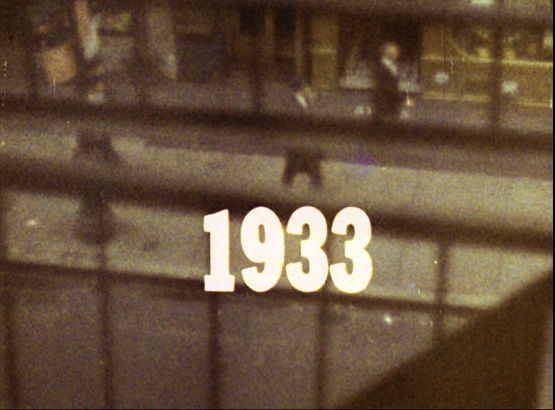 |
|||||
|
|
|
|
|
|
|
 |
|||||
|
|
|
|
|
|
|
| Réalisé par Joyce Wieland |
| Canada, 1967 (expérimental, 4 minutes, couleurs, anglais) |

|
| Image : © Canadian Filmmakers Distribution Centre |
|
Description du film [en anglais] : « The film offers a street scene shot in New York City in the late 1960s from a loft window on the second floor. This shot, filmed mostly in fast motion but occasionally slowed to normal speed, is repeated in its entirety 10 times and is accompanied by dissonant raucous music, evoking the silent-film-like humour in fast motion human movement. » -- University of Toronto Library Catalogue (source) |
« The repeated images are such that they appear to be different each time; to be expanding. 1933 has a machine-mechanical doll rhythmic-like structure. »
-- Robert Cowan
(source)
« Consider 1933—both the numeral that appears superimposed over a street scene, viewed from an upper-storey window, and the title of the film. The ambiguous reference of the numeral opens up an ironic distance: 'Was that footage shot in 1933?' we ask ourselves. Features of the imagery bring us to dismiss that conjecture. 'Is the filmmaker drawing a comparison between 1933 and 1967 (the date the film was made)?' That hypothesis receives no support from the film's structure. 'Does the supertitle have to do with some covert ordering procedure?' The film withholds its answer. [...] »
-- R. Bruce Elder
(source)
« In terms of words, print on the screen, I like 1933 by Joyce Wieland. That's really a miracle. The means are so simple, and the effect is so powerful and unpredictable in terms of the elements. That's really a piece of imagination to have taken such simple elements, put them together, and get such powerful things going. »
-- Kenneth Jacobs
(source)
« At first glance, the structural strategy of 1933 seems perfectly in keeping with the other films in the tradition. There is a feminine specificity in the work of [Joyce] Wieland, however, that is not found in the work of Michael Snow. For like [Marie] Menken's views in Go Go Go, 1933 presents a specific kind of passive alienation from the world going on around the camera. »
-- Walter Metz
(source)
« Joyce Wieland, the wife of Michael Snow, has used loop printing for at least two kinds of structure. In Sailboat the loop gives an illusion of continuous movement as a boat sails from screen left and out of screen right repeatedly; in 1933 a single shot of a street taken from a high window with people rushing in fast motion and slowing down to normal motion (without a change of shots) is seen about a dozen times. Occasionally the title, 1933, is printed over the entire shot, and between each set of repetitions there is white leader marked by different red flashes. »
-- P. Adams Sitney
(source)
« 1933. The year? The number? The title? Was it (the film) made then? It's a memory (i.e. a Film). No, it's many memories. It's so sad and (funny): the departed, departing people, cars, street! It hurries, it's gone, it's back! It's the only glimpse we have but we can have it again. The film (of 1933?) was made in 1967. You find out, if you didn't already know, how naming tints pure vision. »
-- Michael Snow
(source)
|
|
|
|
|
|
|